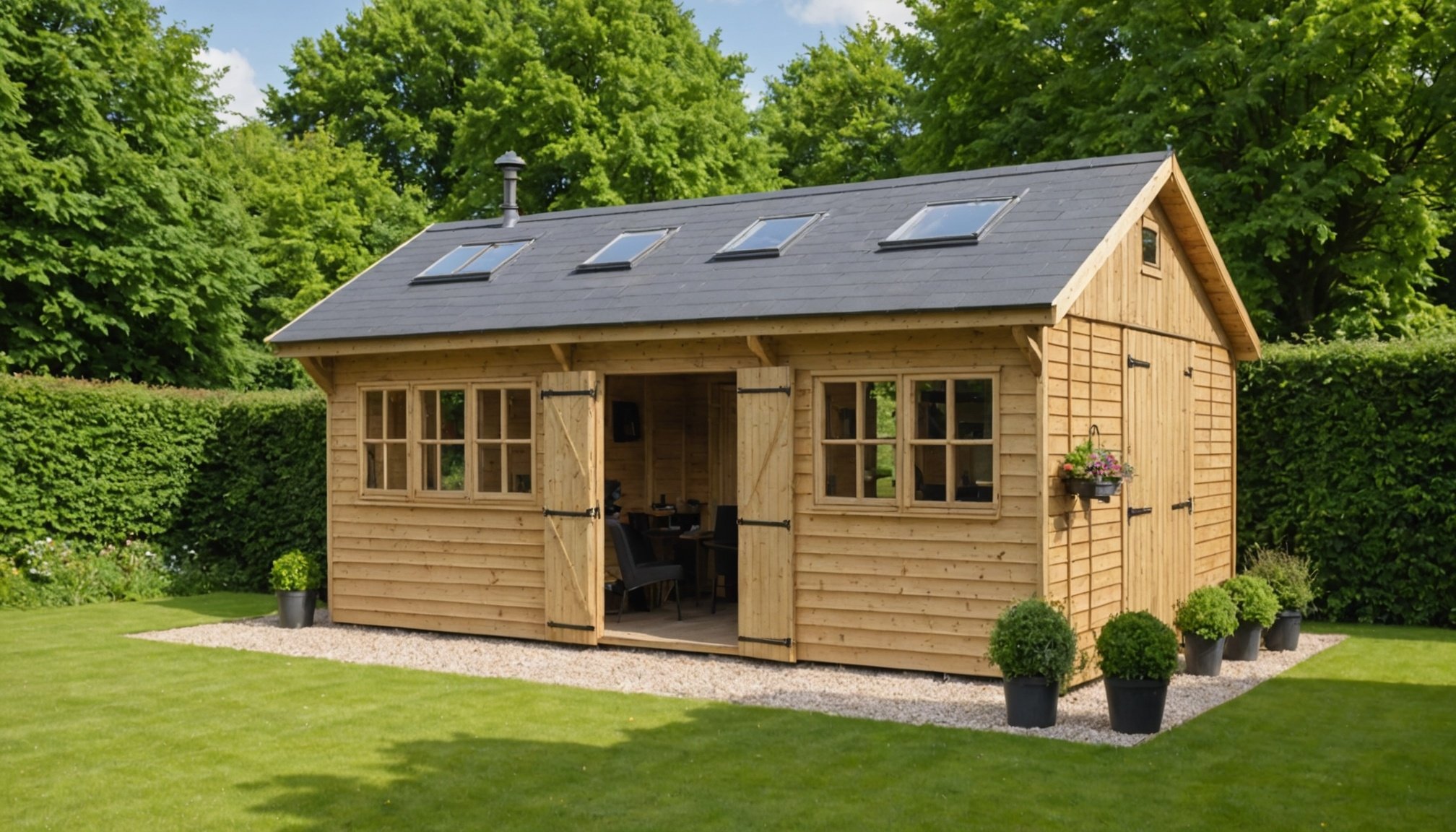Understanding Legal Requirements for Converting Outbuildings
Navigating the legal requirements for converting outbuildings in the UK can be complex, but with the right guidance, it becomes manageable. The primary legislation concerning UK outbuilding conversion includes the Town and Country Planning Act 1990, which outlines necessary permissions and rules.
Planning Permissions
Before embarking on any conversion project, it’s crucial to determine whether planning permissions are required. Generally, planning permission is necessary if you plan to change the use of the outbuilding, increase its size, or alter its appearance significantly. However, certain projects might fall under permitted development rights, allowing modifications without needing full planning permission.
Also read : Safe and Effective Non-Toxic Pest Control Solutions for Your Family Home in the UK
Understanding these permissions begins with checking if your property is in a conservation area or if your building is listed, as these factors affect the permissions needed.
Building Regulations Compliance
Beyond planning permissions, adhering to building regulations is essential to ensure safety and quality. These regulations cover diverse aspects such as insulation, fire safety, and structural integrity. Compliance involves obtaining approval from building control, which might include submitting detailed plans for review.
In parallel : Understanding the Legal Considerations for Exterior CCTV Installation on Semi-Detached Homes in the UK
Successfully navigating these requirements not only safeguards the project legally but also contributes to enhancing the outbuilding’s functionality and market value. Integrating these considerations is a prudent approach to embarking on a transformation that is both innovative and legally sound.
Evaluating Planning Permission Necessities
Understanding the planning permission process is crucial for anyone considering outbuilding conversions. It involves adhering to local council regulations to ensure your project complies with legal standards.
What is planning permission?
Planning permission is an official approval required for conducting certain building projects. Essentially, it serves to ensure that any new development aligns with local policies and community needs. Obtaining planning permission can prevent potential legal penalties and safeguard your investment by validating that your proposal meets environmental and architectural standards.
When is planning permission required?
Planning permission is typically necessary when a project significantly impacts its surroundings. Outbuilding conversions, which alter the use or structure of an existing building, often require this approval. Factors like increased construction height, proximity to property boundaries, or a change in overall usage can trigger the need for planning consent.
How to apply for planning permission
Initiating the application involves consulting with local authorities for guidance tailored to your specific project. Reasons for refusals usually include conflicts with local planning policies or adverse impacts on neighbours. Awareness of these risks can lead to more successful applications.
Applications typically involve fees that vary based on project size, alongside potential costs for hiring professionals for documentation. Processing times average between 8-12 weeks, though this can fluctuate depending on the project’s complexity.
Understanding Building Regulations
Transforming an outbuilding into a functional space requires attention to building regulations. These rules ensure that construction projects safeguard the occupants’ safety and follow structural integrity guidelines. When embarking on an outbuilding conversion, it’s crucial to understand the specific regulations in your local area, which might vary greatly, impacting both design and cost considerations.
Key Building Regulations for Outbuilding Conversions
Ensuring the safety and durability of your converted space begins with complying with essential safety standards. These may include regulations concerning fire safety, ventilation, and energy efficiency—each critical in maintaining a secure and comfortable environment within the converted structure.
Building control plays a pivotal role in this process, as inspectors will typically review plans and inspect the site at crucial stages. Their involvement provides assurance that the project adheres to all outbuilding conversion rules, mitigating potential legal and safety issues that could arise from non-compliance.
By prioritising these regulations, owners can enhance their project’s success. A well-executed compliance strategy not only ensures safety but can also add value to the property, making it an investment worth pursuing. Understanding and navigating these rules can be complex, but the benefits far outweigh the initial effort required in the conversion process.
Estimating Costs for Conversion Projects
Planning an outbuilding conversion can be an exciting yet daunting task. Knowing how to manage outbuilding conversion costs is crucial for project success.
Breakdown of Potential Costs
When diving into financial planning, you need to consider various elements. Structural modifications often form the core of your budget, encompassing materials, labour, and design fees. Electrical and plumbing upgrades further add to expenses. Additionally, purchasing insulation along with heating and cooling systems rounds out the necessary expenditure.
Hidden Costs Homeowners May Not Consider
Homeowners may overlook hidden costs that impact their budgeting. Permits and inspections usually require additional funds—these can range from documentation fees to potential fines if requirements are not properly met. Moreover, unknown structural issues, like damp or unstable foundations, can escalate costs unexpectedly.
Financing Options for Conversions
Exploring various financing options can alleviate financial strain. Traditional loans, like a home equity line of credit or personal loans, provide feasibly accessible options. Furthermore, understanding the importance of detailed budgeting helps manage expenditure efficiently, reducing unforeseen costs.
Anticipating costs associated with permits and inspections is crucial. Notably, some regions offer grants or incentives for conversion projects that integrate sustainable practices. These can include energy efficiency improvements or using eco-friendly materials, providing financial relief for environmentally-conscious conversions.
Tips for Successful Conversion Projects
Engaging in successful outbuilding conversions demands meticulous project management and good forethought. Before embarking on a conversion, it is vital to execute thorough groundwork. Start with a comprehensive assessment of the outbuilding to determine its structural integrity and potential for renovation. Obtaining the necessary permits and approvals is crucial, as it ensures the project complies with local regulations, forestalling future legal complications.
When preparing for a conversion, selecting the right professionals is paramount. Architects and builders with a track record in outbuilding conversions can provide invaluable insights and guidance. Their expertise can facilitate informed decisions, optimizing both the functionality and aesthetics of the project. Seek recommendations, review portfolios, and conduct interviews to ascertain the most suitable team.
During the conversion process, common pitfalls can derail the project. One key challenge is budget management; overruns can quickly escalate. To mitigate this, maintain a detailed budget plan and a contingency fund for unforeseen expenses. Another common issue is inadequate communication among stakeholders. Regular check-ins ensure alignment on objectives and facilitate swift resolution of arising issues.
Above all, success in outbuilding conversion projects hinges on detailed planning, strategic professional selection, and diligent management of potential risks throughout the process.
Real-life Case Studies
Examining case studies of successful conversions provides valuable insights and inspiration for those contemplating similar projects. It’s beneficial to learn from real-life examples where individuals have transformed outbuildings into useful spaces. These case studies demonstrate creative approaches and effective planning.
Examples of Successful Outbuilding Conversions
In numerous case studies, outbuildings have been successfully converted into unique living spaces, such as home offices, guest suites, and even art studios. One standout example is an old barn in the countryside that was repurposed into an airy, modern workspace. The project retained the building’s rustic charm while integrating modern amenities, showing how a balance of old and new can be achieved. Another case featured a garden shed conversion into a serene, self-contained guest room. These success stories highlight the importance of a clear vision and meticulous planning.
Lessons Learned from Failed Projects
Analyzing failed projects is equally important. Common pitfalls include underestimating costs and ignoring zoning laws. In one instance, a homeowner converted a detached garage into a rental unit but overlooked the necessary permits, resulting in legal troubles. Learning from these cases emphasizes the need to navigate legal and planning complexities carefully. Successful conversions often hinge on thorough research and compliance with local regulations.
By examining these inspiring examples and understanding the factors contributing to success, readers can make informed decisions, potentially avoiding costly mistakes.











